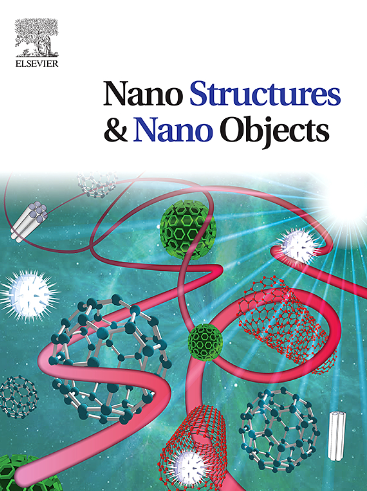Radiative porosity sodium alginate hybrid nanofluid flow over an exponential stretching/shrinking surface: Dual solutions
IF 5.45
Q1 Physics and Astronomy
引用次数: 0
Abstract
An investigation into the effects that porous medium, magnetic fields, thermal radiation, and viscous dissipation have on SA-hybrid nanofluid was the focus of a numerical study that was carried out for a dual branches solution that featured an exponentially stretching and shrinking layer. The principal goal of this study is to explore the behavior of coefficient skin friction and heat transfer with the permeability parameter for the suction aspect, as well as the behavior of solid volume fraction against the stretching/shrinking effect. The impact of the permeability parameter, magnetic, shrinkage parameter, and viscous dissipation on the temperature profile and velocity of sodium alginate-hybrid nanofluid flow are also incorporated in the present investigation. The governing equations in the form of partial differential equations (PDEs) are transformed into the form of ordinary differential equations (ODEs), implementing a similarity variable having exponential similarity. The ODE system is numerically solved using the Three-stage Labatto III-A technique included in the bvp4c solver with the MATLAB program. Two branches’ solutions are obtained when the pertinent parameters are varied over defined ranges. Non unique solutions are obtained when the critical point reaches suction greater or equal to suction critical points and shrinking paramter greater or equal to shrinking paramter critical points for suction and shrinkage effects respectively. In addition, the upper branch has a significant increase in reduced skin friction and heat transfer when the permeability parameter is raised, whereas the lower branch experiences a decrease. The heat transfer rate diminutions in the upper branch solution and increases in the lower branch solution as the solid volume percentage of copper increases. Temperature profiles decrease as permeability parameter values improve. As Eckert's value increases, the temperature profile also improves.
辐射孔隙度海藻酸钠混合纳米流体在指数拉伸/收缩表面上的流动:双重解决方案
研究了多孔介质、磁场、热辐射和粘性耗散对sa -混合纳米流体的影响,并对具有指数拉伸和收缩层的双分支解决方案进行了数值研究。本研究的主要目的是探讨吸力方面的渗透性参数对表面摩擦系数和传热的影响,以及固体体积分数对拉伸/收缩效应的影响。研究了渗透参数、磁性参数、收缩参数和粘滞耗散对海藻酸钠-混合纳米流体温度分布和速度的影响。将偏微分方程形式的控制方程转化为常微分方程形式,实现具有指数相似度的相似变量。利用bvp4c求解器中包含的三级Labatto III-A技术,结合MATLAB程序对ODE系统进行了数值求解。当相关参数在规定范围内变化时,得到了两个分支的解。在吸力和收缩效应的临界点分别达到吸力大于或等于吸力临界点和收缩参数大于或等于收缩参数临界点时,得到非唯一解。此外,当渗透率参数升高时,上支路的减阻和换热显著增加,而下支路的减阻和换热显著降低。随着铜的固体体积百分比的增加,传热速率在上分支溶液中减小,在下分支溶液中增大。温度分布随着渗透率参数的增大而减小。随着Eckert值的增加,温度分布也有所改善。
本文章由计算机程序翻译,如有差异,请以英文原文为准。
求助全文
约1分钟内获得全文
求助全文
来源期刊

Nano-Structures & Nano-Objects
Physics and Astronomy-Condensed Matter Physics
CiteScore
9.20
自引率
0.00%
发文量
60
审稿时长
22 days
期刊介绍:
Nano-Structures & Nano-Objects is a new journal devoted to all aspects of the synthesis and the properties of this new flourishing domain. The journal is devoted to novel architectures at the nano-level with an emphasis on new synthesis and characterization methods. The journal is focused on the objects rather than on their applications. However, the research for new applications of original nano-structures & nano-objects in various fields such as nano-electronics, energy conversion, catalysis, drug delivery and nano-medicine is also welcome. The scope of Nano-Structures & Nano-Objects involves: -Metal and alloy nanoparticles with complex nanostructures such as shape control, core-shell and dumbells -Oxide nanoparticles and nanostructures, with complex oxide/metal, oxide/surface and oxide /organic interfaces -Inorganic semi-conducting nanoparticles (quantum dots) with an emphasis on new phases, structures, shapes and complexity -Nanostructures involving molecular inorganic species such as nanoparticles of coordination compounds, molecular magnets, spin transition nanoparticles etc. or organic nano-objects, in particular for molecular electronics -Nanostructured materials such as nano-MOFs and nano-zeolites -Hetero-junctions between molecules and nano-objects, between different nano-objects & nanostructures or between nano-objects & nanostructures and surfaces -Methods of characterization specific of the nano size or adapted for the nano size such as X-ray and neutron scattering, light scattering, NMR, Raman, Plasmonics, near field microscopies, various TEM and SEM techniques, magnetic studies, etc .
 求助内容:
求助内容: 应助结果提醒方式:
应助结果提醒方式:


